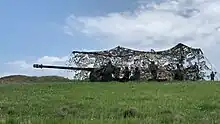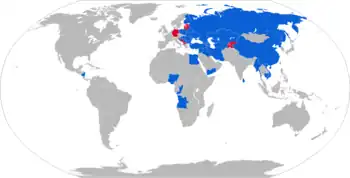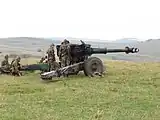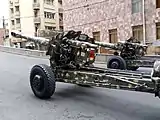| D-20 | |
|---|---|
 | |
| Type | Towed howitzer |
| Place of origin | Soviet Union |
| Service history | |
| Used by | Soviet Union, many others |
| Wars | |
| Production history | |
| Designer | Petrov Artillery Design Bureau |
| Designed | Circa 1947 |
| Manufacturer | Artillery Plant Number 9, Yekaterinburg |
| Specifications | |
| Mass | 5,700 kg (12,600 lb) |
| Length | 8.69 m (28 ft 6 in) |
| Barrel length | 5.195 m (20 ft) L/34 (with muzzle brake) |
| Width | 2.35 m (7 ft 9 in) |
| Height | 1.93 m (6 ft 4 in) |
| Crew | 8 |
| Shell | 152 mm × 547.5 mm (5.98 in × 21.56 in) .R Separate loading charge and projectile[1] |
| Caliber | 152.4 mm (6.00 in) |
| Breech | Vertical semi-automatic sliding-wedge |
| Recoil | hydraulic buffer and hydro-pneumatic recuperator |
| Carriage | Split trail |
| Elevation | -5° to 45° |
| Traverse | 58° |
| Rate of fire | Burst: 5–6 rpm Sustained: 1 rpm |
| Muzzle velocity | 650 m/s (2,100 ft/s) (typical) |
| Effective firing range | 17.4 km (10.8 mi) |
| Maximum firing range | 24 km (15 mi) (rocket assisted projectile) |
| Sights | PG1M indirect sight and OP4M direct fire sight |
The 152 mm gun-howitzer M1955, also known as the D-20, (Russian: 152-мм пушка-гаубица Д-20 обр. 1955 г.) is a manually loaded, towed 152 mm gun-howitzer artillery piece, manufactured in the Soviet Union during the 1950s. It was first observed by the West in 1955, at which time it was designated the M1955. Its GRAU index is 52-P-546.[2]
History
152 mm has been a Russian caliber since World War I, when Britain supplied 6 inch Howitzers and Russia purchased 152 mm guns from Schneider (probably derived from the 155 mm Gun Mle 1877/16) for the Imperial Army. The new gun-howitzer, was a replacement of the pre-war ML-20 gun-howitzer (the 152 mm howitzer M1937) and various World War II era 152 mm field howitzers, Model 09/30, Model 1910/30, Model 1938 M10 and Model 1943 D-1.
By Soviet definition, a 152 mm howitzer is 'medium'-caliber artillery. It was designated a 'gun-howitzer' because its muzzle velocity exceeded 600 m/s, and its barrel length exceeded 30 calibers. It equipped battalions in the motor rifle division artillery regiment and army level artillery brigades.
The design, which was probably initiated in the late 1940s, was first seen in public in 1955. It was designed by the well established design bureau at Artillery Plant No 9 in Sverdlovsk, now Motovilikha Plants in Yekaterinburg, led by the eminent artillery designer Fyodor Fyodorovich Petrov, who was responsible for several World War II pieces. The gun's factory designation was "D-20".
The carriage is the same one used for the D-74 122 mm field gun. The barrel assembly is the basis for the D-22 (GRAU index: 2A33), which is used for the self-propelled 2S3 Akatsiya ("Acacia").
Description

The D-20 has a 26 caliber (3.962 m) barrel, with a double baffle muzzle brake and a semi-automatic vertical sliding-block breech, with a tied jaw and the block moving down to open. The barrel is mounted in a long ring cradle with the trunnions just forward of the breech. The recoil system (buffer and recuperator) is mounted on the cradle above the barrel. Compression balancing gear is attached behind the saddle support, passing through the complex shaped saddle to connect to the cradle just forward of the trunnions. This can be manually repressured by a pump below the breech. The breech has a projectile retaining catch to prevent the shell sliding out at higher elevations before it is rammed with a manual rammer.
Top traverse totals 58° and the vertical elevation range is −5° to 45°.
Box girder section split trail legs are hinged to the cradle support, with bolts to lock them into either the open or closed position. The cradle support has a bolt for locking the barrel in the centre for traverse before towing the gun. Large spades are permanently fixed close to the end of each trail. These are hinged and it appears that the gun can be fired with them up or down depending on the terrain. They are always up when the gun is towed.
To assist with all-round carriage traverse, there is a pivot jack mounted at the front of the cradle support. The pivot jack is not a sole plate and the gun fires with its foam filled rubber tyred wheels supporting the gun on the ground. When the gun is brought into action, the pivot jack is folded down and adjusted to be on the ground. If a large traverse is required, small jacks on each trail leg are rotated downwards, and the trails jacked up until the main wheels are lifted clear of the ground and the bogey wheels mounted on each trail leg swung downwards and the trail jacks raised. The carriage is then traversed, and the trail jacks reused to lift the bogey wheels and then place the piece back on its main wheels.
The pivot jack is used to secure the barrel against vertical movement when the gun is being towed. The barrel is locked in the centre for traverse with a bolt on the cradle support. The jack is folded upwards, lugs on the ring cradle engage the jack base and two tensioners fixed to the saddle support are hooked to the cradle. These are tightened to lock the cradle onto the jack base.
As was normal for the period, the gun has a shield, including a folding piece below the cradle support. The centre section of the upper shield slides both up and down, and folds to accommodate the barrel at higher elevation angles of fire. The shield may offer some protection against muzzle blast to the sights and layer, although it is usually shown being fired with a long lanyard, but is probably mostly for defence against machine gun fire.
The non-reciprocating sights are standard Soviet pattern, designed for one-man laying. Included are a direct fire anti-tank telescope (OP4M), a panoramic periscopic indirect-fire sight, a dial sight, (PG1M) in a mounting, an angle of sight scale, and a range drum for each charge engraved with the range (distance) scale, coupled to an elevation leveling bubble mounted on dial sight mount. The range drum enables the standard Soviet technique of semi-direct fire when the piece is laid visually on the target, and the range set on the range drum.
Like most Soviet artillery, the gun fires separate ammunition using metal cartridge cases that also provide obturation. The ammunition is interchangeable with that used with other 152 mm guns, although the more modern ones have a third, much larger cartridge. The D-20 uses two types of cartridge. One has a base charge and up to five increments, the other is a single 'super' charge cartridge.
The standard shell weight is 44 kg with a muzzle velocity of 655 m/s, but some projectiles are more or less than this. The basic shell is high explosive (HE) and Fragmentation (HE-Frag). Other projectiles include smoke, illuminating, chemical and probably incendiary.
Later projectiles include bomblet, anti-personnel land mine, flechette, Krasnopol precision-guided munition (PGM), communication jammer, and extended range HE using rocket assistance (RAP). The normal maximum range is 17.4 km, RAP being farther. Two direct-fire anti-tank projectiles have been used, high-explosive anti-tank (HEAT) and armour-piercing ammunition (APHE), the latter being 5.2 kg heavier and with a lower muzzle velocity.
The maximum rate of fire is usually stated as five rounds/minute, and 65 rounds/hour sustained. In Soviet service, the unit of fire was 60 rounds.
The detachment was either 8 or 10 men, probably differing between armies and the time period. In Soviet service, the 5,700 kg gun was usually towed by a URAL-375 6×6 truck or, in some regions, an AT-S or AT-L medium tractor.
Operational history
During the 2022 invasion of Ukraine both sides have relied on the D-20.[3][4] Russian forces have started deploying the weapons from storage.[3] There are reports of at least one Russian D-20 being destroyed due to poor ammunition. This weapon was in the service of the Luhansk People’s Republic.[5]
Variants
Russian Federation
- The Khitin is an improved version with an automatic rammer for an increased firing rate of 7-8 rds/min.
People's Republic of China
Democratic People’s Republic of Korea
The US Defense Intelligence Agency has reported the existence of several self-propelled artillery systems, mating existing cannon systems with a locally designed chassis. The SPH 152mm M1974 appears to be a D-20 or Type 66 mounted on a tracked chassis Tokchon.[6]
Similar weapons
Romania

- A411 – System designed by Arsenalul Armatei. Very similar to D-20, but has different 152 mm ordnance, 25 calibers long, range of 17.2 km (24 km with OF-550 projectile); in Romanian Army; known as 152 mm towed gun-howitzer M1981 (Romanian: Tun/Obuzier calibrul 152-mm tractat M1981)[6]
- A412 – License-built Chinese Type 59-1 with a D-20 carriage. In Romanian Army, is known as 130 mm towed gun M1982 (Romanian: Tun calibrul 130-mm tractat M1982)[6]
- A425 – Variant using D-20 carriage. Designed in Romania using Chinese technology, 152 mm ordnance, 34 calibers long, performs similar to 152 mm howitzer 2A65 "Msta-B"; maximum range is 22–24 km; in Romanian Army, is known as 152 mm towed gun-howitzer M1985 (Romanian: Tun/Obuzier calibrul 152-mm tractat M1985); offered for export as Model 1984[6]
Former Yugoslavia
- Gun-howitzer M84 NORA or NORA (Serbo-Croatian: novo oružje artiljerije) – On the basis of construction documents for the D-20 and experience with producing the M114 155 mm howitzer, this new type of weapon with greater range was developed by Military Technical Institute Belgrade. While it retains some elements of the original carriage, almost everything else is redesigned and modernized starting with the barrel, which is replaced by the new L/39.7 barrel.
Ammunition
- HE-Frag, OF-32 – range 17,400 meters
- DPICM
- DPICM-BB
- Incendiary
- Expendable jammer
- Chemical
- Flechette
- Semi-active laser-guided "Krasnopol"
Source:[7]
Wars
- Vietnam War[8]
- Sino-Indian War
- Indo-Pakistani War of 1965
- Six-Day War
- War of Attrition
- Sino-Soviet border conflict
- Yom Kippur War
- Lebanese Civil War
- Soviet–Afghan War
- Sino-Vietnamese War
- Iran–Iraq War
- Sri Lankan Civil War
- Gulf War
- Iraq War
- Yugoslav wars
- Syrian Civil War
- War in Donbass
- Iraqi Civil War (2014–2017)
- Yemeni Civil War (2015–present)
- 2022 Russian invasion of Ukraine[3][4]
Operators

Current
 Angola – 4 as of 2016[9]
Angola – 4 as of 2016[9] Armenia – 34 as of 2016[10]
Armenia – 34 as of 2016[10] Azerbaijan – 24 as of 2016[11]
Azerbaijan – 24 as of 2016[11] Bulgaria – 44 as of 2016[12]
Bulgaria – 44 as of 2016[12] Democratic Republic of the Congo – 6[13]
Democratic Republic of the Congo – 6[13] Ethiopia – 20
Ethiopia – 20 Georgia – 12 received from Bulgaria in 2009[14]
Georgia – 12 received from Bulgaria in 2009[14] People's Republic of China – Type 66[15]
People's Republic of China – Type 66[15] Republic of the Congo[16]
Republic of the Congo[16] Hungary – 18 as of 2016[17]
Hungary – 18 as of 2016[17] Iran – 30 as of 2016[18]
Iran – 30 as of 2016[18] Iraq – All destroyed in 2003 invasion of Iraq, new models bought from Bulgaria in 2015[19]
Iraq – All destroyed in 2003 invasion of Iraq, new models bought from Bulgaria in 2015[19]
 Iraqi Kurdistan[20] – 6 captured from Iraqi Army in 1991, 4 captured in 2003, 10 in total used by Kurdistan Democratic Party (KDP) Peshmerga
Iraqi Kurdistan[20] – 6 captured from Iraqi Army in 1991, 4 captured in 2003, 10 in total used by Kurdistan Democratic Party (KDP) Peshmerga
 Laos – in service as of January 2019[21]
Laos – in service as of January 2019[21] Moldova – as of 2016[22]
Moldova – as of 2016[22] Myanmar – 35 delivered in 2009 from North Korea[23]
Myanmar – 35 delivered in 2009 from North Korea[23] Nicaragua – 12 serving, 30 stored as of 2016[24]
Nicaragua – 12 serving, 30 stored as of 2016[24] Nigeria – 4 M81/M85 from Romanian Army stocks
Nigeria – 4 M81/M85 from Romanian Army stocks Russia – 1,075 as of 2016[25]
Russia – 1,075 as of 2016[25] Romania – Romanian Army has 247 M81 howitzers, 103 M85 gun-howitzers[26]
Romania – Romanian Army has 247 M81 howitzers, 103 M85 gun-howitzers[26] Sri Lanka – 46 Type 66 as of 2016[27]
Sri Lanka – 46 Type 66 as of 2016[27] Syria[28]
Syria[28] Turkmenistan – 72 as of 2016[29]
Turkmenistan – 72 as of 2016[29] Ukraine – 130+ as of 2016[30]
Ukraine – 130+ as of 2016[30] Vietnam[31]
Vietnam[31] Yemen[32]
Yemen[32]
Former
 Albania – 90 type 66 supplied from 1968–1973[14]
Albania – 90 type 66 supplied from 1968–1973[14] Artsakh − Seized by Azerbaijan after the 2023 Azerbaijani offensive in Nagorno-Karabakh[33]
Artsakh − Seized by Azerbaijan after the 2023 Azerbaijani offensive in Nagorno-Karabakh[33] Belarus[14]
Belarus[14] Cuba – 100, supplied between 1972–1974[14]
Cuba – 100, supplied between 1972–1974[14] East Germany – 137 supplied in 1974–1975,[14] passed to Germany after German unification
East Germany – 137 supplied in 1974–1975,[14] passed to Germany after German unification Egypt – 300 supplied between 1964–1970[14]
Egypt – 300 supplied between 1964–1970[14] Finland – 126 bought from ex-DDR in 1991; phased out 2017; known as 152 H 55[14]
Finland – 126 bought from ex-DDR in 1991; phased out 2017; known as 152 H 55[14] Germany – Phased out
Germany – Phased out Kazakhstan
Kazakhstan North Korea – 200 possibly supplied by China in 1972–1975[14]
North Korea – 200 possibly supplied by China in 1972–1975[14] Soviet Union – passed to successor states
Soviet Union – passed to successor states Uzbekistan
Uzbekistan.svg.png.webp) Yugoslavia – 36 supplied in 1971[14]
Yugoslavia – 36 supplied in 1971[14]
Gallery
 An Iranian D20 during the Iran–Iraq War.
An Iranian D20 during the Iran–Iraq War. A Chinese Type 66 Howitzer at the Flying Leatherneck Aviation Museum.
A Chinese Type 66 Howitzer at the Flying Leatherneck Aviation Museum. A Romanian M1981.
A Romanian M1981. A Serbian Army M-84 Nora-A 152 mm howitzer at military parade in Niš.
A Serbian Army M-84 Nora-A 152 mm howitzer at military parade in Niš. An Armenian Army D-20 during the military parade in Yerevan
An Armenian Army D-20 during the military parade in Yerevan
See also
References
- ↑ Foss, Christopher (1977). Jane's Pocket Book of Towed Artillery. New York: Collier. p. 113. ISBN 0020806000. OCLC 911907988.
- ↑ "Пушки" [Guns]. Archived from the original on 31 March 2012. Retrieved 29 August 2011.
- 1 2 3 "Russian Offensive Campaign Assessment, June 13". understandingwar.org. 13 June 2022. Archived from the original on 14 June 2022. Retrieved 14 June 2022.
- 1 2 "The work of Ukrainian Howitzers D-20 and MLRS BM-21 "Hail"". understandingwar.org. Retrieved 14 June 2022.
- ↑ "Photos: Did a Russian Howitzer Explode in Ukraine Because Of Improper Storage?". 19fortyfive.com. 11 June 2022. Retrieved 14 June 2022.
- 1 2 3 4 5 Janes Armour and Artillery 2003-2004
- ↑ Pike, John. "D-20 / M-55 152-mm Towed Gun-Howitzer Type-66 152-mm Towed Gun-Howitzer". Military Analysis Network. Bottom of Page. Retrieved 1 August 2023.
- ↑ Ezell, Edward Clinton (1988). Personal firepower. The Illustrated history of the Vietnam War 15. Bantam Books. p. 153. ISBN 9780553345490. OCLC 1036801376.
- ↑ Military Balance 2016, p. 429.
- ↑ Military Balance 2016, p. 178.
- ↑ Military Balance 2016, p. 180.
- ↑ Military Balance 2016, p. 82.
- ↑ International Institute for Strategic Studies (2021). The Military Balance. p. 461. ISBN 9781032012278.
- 1 2 3 4 5 6 7 8 9 "Trade Registers". Armstrade.sipri.org. Retrieved 5 January 2019.
- ↑ Military Balance 2016, p. 242.
- ↑ Military Balance 2016, p. 438.
- ↑ Military Balance 2016, p. 107.
- ↑ Military Balance 2016, p. 328.
- ↑ Binnie, Jeremy. "Iraq receives Bulgarian D-20 guns". IHS Jane's 360. IHS. Retrieved 29 July 2015.
- ↑ Military Balance 2016, p. 491.
- ↑ Gibson, Neil; Fediushko, Dmitry (22 January 2019). "Laotian military parades Russian- and Chinese-made equipment". Jane's 360. London, Moscow. Archived from the original on 23 January 2019. Retrieved 24 January 2019.
- ↑ Military Balance 2016, p. 188.
- ↑ The Military Balance 2020. Routledge. 14 February 2020. p. 296. ISBN 978-0367466398.
- ↑ Military Balance 2016, p. 406.
- ↑ Military Balance 2016, p. 190.
- ↑ Military Balance 2016, p. 132.
- ↑ Military Balance 2016, p. 289.
- ↑ Military Balance 2016, p. 354.
- ↑ Military Balance 2016, p. 203.
- ↑ Military Balance 2016, p. 205.
- ↑ Military Balance 2016, p. 297.
- ↑ Mitzer, Stijn; Oliemans, Joost (20 September 2015). "The Oryx Handbook of Pre-war Yemeni Fighting Vehicles". Oryx.
- ↑ Mitzer, Stijin; Oliemans, Joost. "Documenting Equipment Losses During The September 2023 Nagorno-Karabakh Conflict". Oryx. Retrieved 7 October 2023.
- International Institute for Strategic Studies (February 2016). The Military Balance 2016. Vol. 116. Routlegde. ISBN 9781857438352.